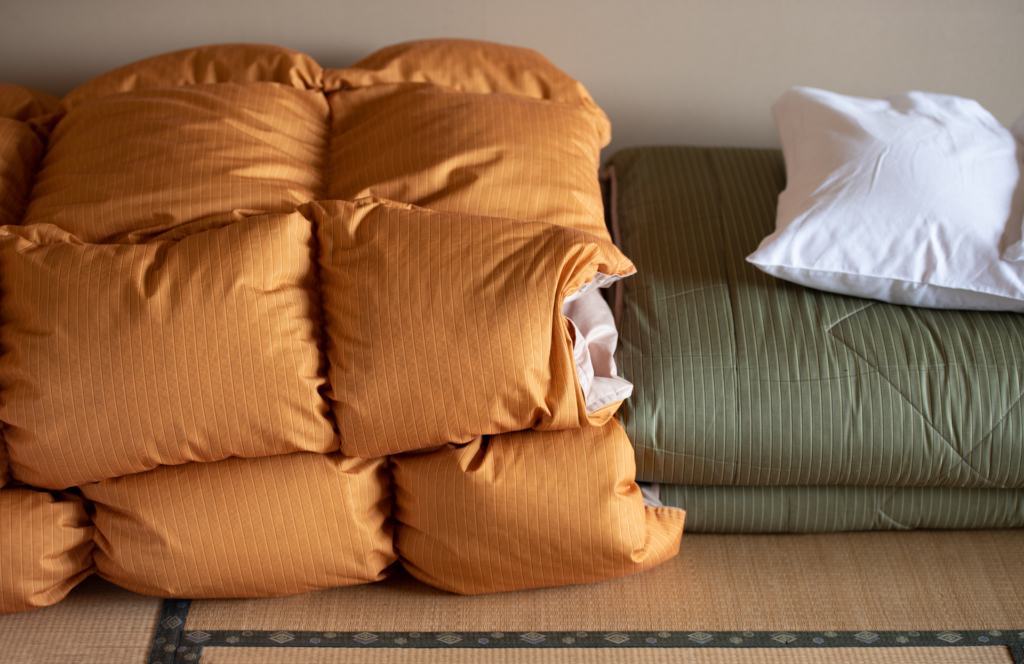Congratulations, you’ve finally made it to Japan! As you start moving into your apartment and settling down, you’ll need to start putting together a shopping list. Hopefully one of the first items on your shopping list is a new bed. While Googling photos of beds in Japan will yield plenty of images of traditional futons, there are actually many different types of beds suitable for different rooms. Whether you’re in a tatami or carpeted room, we’ve outlined five different types of beds commonly used in Japan and the best places you can buy them.
Traditional Japanese Futon

The Japanese futon is associated heavily with the traditional image of Japan. While many English speakers might imagine futons as a thin mattress on a foldable sofa frame, in Japan, the word actually refers to a style of bedding that lays directly on the floor.
Even though futon are becoming less and less common in Japanese homes, they can still be easily purchased and are often the bed of choice in ryokan (traditional inns). These can be a cheap option to start with, since the cheapest futon sets start from 5,000 JPY. The futon is made of 100% cotton and is composed of 5 different parts:
- Shikibuton (futon mattress)
- Shiitsu (flat sheet)
- Kakebuton (comforter)
- Fitted sheet
- Mofu (blanket)
How to Make a Japanese Bed
Unlike Western-style beds, which require a bed frame and a mattress, the Japanese futon lays directly on the floor. It’s quite easy to set up a futon; we have a manga guide here! First, lay the shikibuton on the floor. Next, spread the sheets on top of the futon, and then fold the excess underneath for a tight fit. Then, cover the kakebuton with the fitted sheet, and lay the solid side down on the mattress, while leaving the oval-shaped side facing upward.

As for pillows, one common type of Japanese pillow is filled with little beads, which conform to the shape of your neck and head and help give you a good night’s sleep. The Japanese futon is usually laid on tatami mats rather than hardwood floors, as the mats are much softer and provide more support.

Japanese futon beds are supposed to be stored away when they’re not in use. This helps free up space in the room during the day and prevents the futon from collecting dust and dirt. Despite their appearance, traditional Japanese beds are quite comfortable to sleep on. However, if you’re sleeping on a hardwood floor or simply want extra comfort, then adding a tri-fold mattress should help provide some extra comfort and support while still being storable.
Sofa Bed

Another great option to compliment the small size of Japanese apartments are sofa beds. Similar to Western-style futon beds, sofa beds can function as both a sleeping and sitting space. While not featuring the most dazzling designs, the cheapest sofa beds can be purchased starting from 5,000 JPY. More expensive sofa beds offer better designs, levels of comfort, and storage options. They’re a great way to free up some space in your Japanese apartment; however, they can be quite uncomfortable to sleep on if you’re taller than 160cm.
Tatami Platform Bed

A modern take on the Japanese futon, tatami platform beds offer Western-style bedding while still giving the user a more traditional feel. Unlike Western-style beds, the frame is still low to the floor. Also, instead of being made entirely of wood, the inside of the frame is made of tatami bamboo. The bed frames start at about 15,000 JPY, while more designs and sizing options are available for higher prices. The frames can be used with either a traditional Japanese futon or a Western-style mattress, although Western mattresses seem to be the more popular choice.
Western-Style Bedding

The most common type of bed found in Japanese households is the Western-style mattress and bedding. The bed frames can be costly, with the most basic frames starting at 20,000 yen. However, the beds are made to last for a long time and give extra storage to the users. Western beds also have a variety of different sizes compared to the Japanese futon. The shikibuton typically come in the single size, while Western mattresses come in twin, semi-double, double, queen, and king sizes.
Ashitsuki Mattress
Ashitsuki (“legs attached”) mattresses are convenient if you want the comfort of a Western bed on a tight budget. As an expat, investing in a mattress and bed frame can set you back quite a few yen. So if you don’t want to spend too much on a bed in Japan but still want the comfort of a Western mattress, then an ashitsuki mattress might be a good choice. The removable legs attached to the bed give the mattress some height, freeing up some space in your home. In the future, if you decide to purchase a bed frame, then the legs can be removed, leaving a regular mattress.
Although they are cheaper than a full bed set, they don’t provide a lot of extra space underneath. There have also been some complaints that you can only buy bedsheets from the store you bought your bed from, as those from other retailers might not fit the mattress. However, they are often sized with general Japanese sizes, which include single, semi-double, double, etc., so you can try sheets that are marketed as the same size.
Bed Sizes

Japanese and American size bed measurements are slightly different from each other. The standard size for beds in the US are as follows; twin (99x191cm), full (137x191cm), queen (152x203cm), and king (193x203cm). Due to the small size of Japanese apartments, the size of standard beds in Japan are a little bit smaller: single (97x195cm), semi-double (120x195cm), double (140x195cm), queen (152x195cm), and king (180x195cm). Both regular mattresses and ashitsuki mattresses come in these sizes. For a one-room apartment, it’s recommended to settle for either a single or semi-double sized bed to maximize the space in your apartment.
Where to Buy

There are a variety of stores in Japan where you can find all these types of beds. The two most popular Japanese stores are Muji and Nitori. Muji is known by everyone for its minimalist designs and simple packaging. It’s not the cheapest place to shop, but it’s a good option compared to more recognized brands and boutiques.
Nitori is similar to Muji in that a lot of the furniture features minimal designs, but it offers much cheaper prices. Ikea has also recently gained popularity in Japan, with its Western designs and delicious food. For shoppers, Ikea and Nitori are both considered affordable options for buyers looking for nice furniture at a good price.

Other notable retailers to consider if you don’t like visiting physical stores are Rakuten and Amazon Japan. They both carry affordable and higher-priced items, and delivery from each site takes a minimum of two weeks. Amazon Japan is a more familiar brand for English-speakers and is easy to navigate in both English and Japanese.
Rakuten is very popular among Japanese customers, as the site offers a wide collection of bedding options in different styles at affordable prices; with some careful digging, you can even find some good second-hand items on there. However, Rakuten does not offer an English website or a furniture-assembly option, and since the instructions will likely be in Japanese, it could prove difficult to assemble on one’s own.
Second-Hand Stores

Although in the West, people take a more cautious approach when shopping in second-hand stores, here in Japan they’re often a buyer’s first destination. Second-hand items in Japan are often well taken care of, and it’s easy to find items in like-new or gently-used condition. Some popular second-hand stores in Japan include Off-House and 2nd Street. Off-House sells everything house-related from clothes, to kitchenware to furniture as well. 2nd Street also sells furniture, but the store focuses mostly on clothing, leaving a smaller selection of furniture to choose from compared to Off-House.
Conclusion
There is no one-size-fits-all option when it comes to purchasing a bed in Japan. Depending on your room type and sleeping needs, you can find a comfortable bed that fits your budget. We hope this article helped you with your search for choosing the best bed in Japan.
Title image credit: Scott-lee / Shutterstock.com
If you want to give feedback on any of our articles, you have an idea that you’d really like to see come to life, or you just have a question on Japan, hit us up on our Facebook!
The information in this article is accurate at the time of publication.

